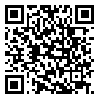Masoud Shafiee Motlagh1 
 , Ali Sobhani dargah *2
, Ali Sobhani dargah *2 
 , Amirali Shad
, Amirali Shad 
 , Amirreza Babaei
, Amirreza Babaei 
 , Mohamad Dinarvand
, Mohamad Dinarvand 
 , Arman Hedayati
, Arman Hedayati 


 , Ali Sobhani dargah *2
, Ali Sobhani dargah *2 
 , Amirali Shad
, Amirali Shad 
 , Amirreza Babaei
, Amirreza Babaei 
 , Mohamad Dinarvand
, Mohamad Dinarvand 
 , Arman Hedayati
, Arman Hedayati 

1- 1. Occupational Health and Safety Research Center, Institute of Health Sciences and Technologies, Hamadan University of Medical Sciences, Hamadan, Iran , 2. Center of Excellence for Occupational Health, Hamadan University of Medical Sciences, Hamadan, Iran
2- 2. Center of Excellence for Occupational Health, Hamadan University of Medical Sciences, Hamadan, Iran2. Center of Excellence for Occupational Health, Hamadan University of Medical Sciences, Hamadan, Iran 3. Student Research Committee, Hamadan University of Medical Sciences, Hamadan, Iran ,Alisobhanidargah@gmail.com
2- 2. Center of Excellence for Occupational Health, Hamadan University of Medical Sciences, Hamadan, Iran2. Center of Excellence for Occupational Health, Hamadan University of Medical Sciences, Hamadan, Iran 3. Student Research Committee, Hamadan University of Medical Sciences, Hamadan, Iran ,
Abstract: (533 Views)
Introduction: Glass manufacturing factories face challenges such as noise and heat as they are one of the industries that expose employees to harmful physical factors. This study aims to design and validate a chamber to reduce workers’ exposure to noise and heat while providing desire lighting in a glass manufacturing industry.
Methods: In this study, the heat exposure of 16 workers was evaluated using the Wet Bulb Globe Temperature (WBGT) index measured with a calibrated QUESTEMP 10 device, as well as perceived stress index (PeSI). Environmental noise was measured using a calibrated Casella CEL-450 sound level meter. The chamber design included calculations of thermal loads and air conditioning inside the chamber using psychrometric charts and determination of sound transmission loss. The effectiveness of the chamber was simulated with WBGT and noise maps at 48 measurement stations using Surfer 21.6.216 software. Additionally, an artificial lighting system was designed using DIALux version 13.4.
Findings: The highest and lowest WBGT values were 40.36 and 17.82 degrees Celsius, respectively. The average perceived stress of the first and second shift workers was 0.86 ± 8.41 and 0.88 ± 7.66, respectively. The sound pressure level in the production hall was measured at 94.16 dB, which was estimated to be about 74.16 dB inside the chamber. The average illumination intensity was measured at 304 lux, with a uniformity ratio of 0.63.
Discussion and Conclusion: The designed chamber effectively reduces noise and heat exposure in the glass manufacturing industry, while ensuring adequate lighting for employees.
Methods: In this study, the heat exposure of 16 workers was evaluated using the Wet Bulb Globe Temperature (WBGT) index measured with a calibrated QUESTEMP 10 device, as well as perceived stress index (PeSI). Environmental noise was measured using a calibrated Casella CEL-450 sound level meter. The chamber design included calculations of thermal loads and air conditioning inside the chamber using psychrometric charts and determination of sound transmission loss. The effectiveness of the chamber was simulated with WBGT and noise maps at 48 measurement stations using Surfer 21.6.216 software. Additionally, an artificial lighting system was designed using DIALux version 13.4.
Findings: The highest and lowest WBGT values were 40.36 and 17.82 degrees Celsius, respectively. The average perceived stress of the first and second shift workers was 0.86 ± 8.41 and 0.88 ± 7.66, respectively. The sound pressure level in the production hall was measured at 94.16 dB, which was estimated to be about 74.16 dB inside the chamber. The average illumination intensity was measured at 304 lux, with a uniformity ratio of 0.63.
Discussion and Conclusion: The designed chamber effectively reduces noise and heat exposure in the glass manufacturing industry, while ensuring adequate lighting for employees.
Article number: 1
Type of Study: Research Article |
Subject:
Physical agents
Send email to the article author
| Rights and permissions | |
 |
This work is licensed under a Creative Commons Attribution-NonCommercial 4.0 International License. |
